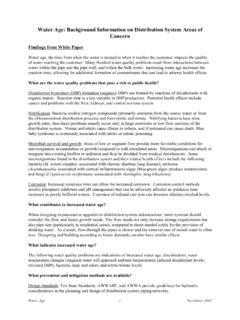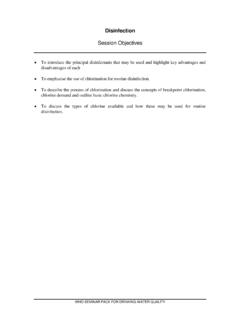Transcription of Finished Water Storage Facilities - US EPA
1 _____ Office of Water (4601M) Office of Ground Water and Drinking Water distribution system Issue Paper Finished Water Storage Facilities August 15, 2002 PREPARED FOR: Environmental Protection Agency Office of Ground Water and Drinking Water Standards and Risk Management Division 1200 Pennsylvania Ave., NW Washington DC 20004 Prepared by: AWWA With assistance from Economic and Engineering Services, Inc Background and Disclaimer The USEPA is revising the Total Coliform Rule (TCR) and is considering new possible distribution system requirements as part of these revisions. As part of this process, the USEPA is publishing a series of issue papers to present available information on topics relevant to possible TCR revisions. This paper was developed as part of that effort.
2 The objectives of the issue papers are to review the available data, information and research regarding the potential public health risks associated with the distribution system issues, and where relevant identify areas in which additional research may be warranted. The issue papers will serve as background material for EPA, expert and stakeholder discussions. The papers only present available information and do not represent Agency policy. Some of the papers were prepared by parties outside of EPA; EPA does not endorse those papers, but is providing them for information and review. Additional Information The paper is available at the TCR web site at: Questions or comments regarding this paper may be directed to Prepared by AWWA with assistance from Economic and Engineering Services, Water Storage goal of this document is to review existing literature, research and information on thepotential public health implications associated with covered Storage Water Storage Facilities are an important component of the protective distribution system barrier that prevents contamination of Water as it travels to the customer.
3 Historically, finishedwater Storage Facilities have been designed to equalize Water demands, reduce pressurefluctuations in the distribution system ; and provide reserves for fire fighting, power outages andother emergencies. Many Storage Facilities have been operated to provide adequate pressure andhave been kept full to be better prepared for emergency conditions. This emphasis on hydraulicconsiderations in past designs has resulted in many Storage Facilities operating today with largerwater Storage capacity than is needed for non-emergency usage. Additionally, some storagefacilities have been designed such that the high Water level is below the hydraulic grade line ofthe system , making it very difficult to turnover the tank. If the hydraulic grade line of the systemdrops significantly, very old Water may enter the system .
4 If tanks are kept full yet areunderutilized, the stored Water ages and Water quality is main categories of Finished Water Storage Facilities include ground Storage and elevatedstorage. Finished Water Storage does not include Facilities such as clearwells that are part oftreatment or contact time requirements per the Surface Water Treatment Rules. Ground storagetanks or reservoirs can be below ground, partially below ground, or constructed above groundlevel in the distribution system and may be accompanied by pump stations if not built atelevations providing the required system pressure by gravity. Ground Storage reservoirs can beeither covered or uncovered. Covered reservoirs may have concrete, structural metal, or flexiblecovers. The most common types of elevated Storage are elevated steel tanks and standpipes.
5 Inrecent years, elevated tanks supported by a single pedestal have been constructed where aestheticconsiderations are an important part of the design process. A standpipe is a tall cylindrical tanknormally constructed of steel, although concrete may be used as well. The standpipe functionssomewhat as a combination of ground and elevated Storage . Only the portion of the storagevolume of a standpipe that provides Water at or above the required system pressure is considereduseful Storage for pressure equalization purposes. The lower portion of the Storage acts tosupport the useful Storage and to provide a source of emergency Water supply. Many standpipeswere built with a common inlet and of Potential Water Quality ProblemsWater quality problems in Storage Facilities can be classified as microbiological, chemical orphysical.
6 Excessive Water age in many Storage Facilities is probably the most important factorrelated to Water quality deterioration. Long detention times, resulting in excessive Water age, canbe conducive to microbial growth and chemical changes. The excess Water age is caused by 1)under utilization ( , Water is not cycled through the facility), and 2) short circuiting within thereservoir. Poor mixing (including stratification) can exacerbate the Water quality problems byPrepared by AWWA with assistance from Economic and Engineering Services, zones within the Storage facility where Water age significantly exceeds the averagewater age throughout the facility. distribution systems that contain Storage Facilities where watercascades from one facility to another (such as pumping up through a series of pressure zones)can result in exceedingly long Water age in the most distant tanks and reservoirs.
7 Although thestorage facility is normally an enclosed structure, numerous access points can become entrypoints for debris and contaminants. These pathways may include roof top access hatches andappurtenances, sidewall joints, vent and overflow 1 provides a summary of Water quality problems associated with Finished Water 1 Summary of Water Quality Problems Associated with Finished Water Storage FacilitiesChemical IssuesBiological IssuesPhysical IssuesDisinfectant DecayMicrobial Regrowth*CorrosionChemical Contaminants*Nitrification*Temperature/S tratificationDBP Formation*Pathogen Contamination*Sediment*Taste and OdorsTastes and Odors* Water quality problem with direct potential health issues listed in Table 1 can deteriorate Water quality, but only those with direct potentialhealth impacts (identified by an asterisk)
8 Are discussed in the following sections or in otherWhite Health ImpactsVarious potential health impacts have been associated with the chemical and biological issuesidentified in Table 1. The Chemical Health Effects Tables ( Environmental ProtectionAgency, 2002a) provides a summary of potential adverse health effects from high/long-termexposure to hazardous chemicals in drinking Water . The Microbial Health Effects Tables ( Protection Agency, 2002b) provides a summary of potential health effects fromexposure to waterborne accumulation occurs within Storage Facilities due to quiescent conditions whichpromote particle settling. Potential Water quality problems associated with sedimentaccumulation include increased disinfectant demand, microbial growth, disinfection by-productformation, and increased turbidity within the bulk Water .
9 Instances of microbial contaminationand disinfection by-product formation due to Storage facility sediments are described in thePathogen Contamination and Microbial Growth section and the Disinfection By-Productformation section, Pathogen Contamination and Microbial GrowthPrepared by AWWA with assistance from Economic and Engineering Services, contamination from birds or insects is a major Water quality problem in Storage tank inspection firm that inspects 60 to 75 tanks each year in Missouri and southern Illinoisreports that 20 to 25 percent of tanks inspected have serious sanitary defects, and eighty to ninetypercent of these tanks have various minor flaws that could lead to sanitary problems (Zelch2002). Most of these sanitary defects stem from design problems with roof hatch systems andvents that do not provide a watertight seal.
10 Older cathodic protection systems of the hangingtype also did not provide a tight seal. When standing inside the tank, daylight can be seenaround these fixtures. The gaps allow spiders, bird droppings and other contaminants to enterthe tank. Zelch (2002) reports a trend of positive total coliform bacteria occurrences in the falldue to Water turnover in tanks. Colder Water enters a tank containing warm Water , causing thewater in the tank to turn over. The warm Water that has aged in the tank all summer isdischarged to the system and is often suspected as the cause of total coliform Facilities have been implicated in several waterborne disease outbreaks in the UnitedStates and Europe. In December 1993, a Salmonella typhimurium outbreak in Gideon, Missouriresulted from bird contamination in a covered municipal Water Storage tank (Clark et al.)

















